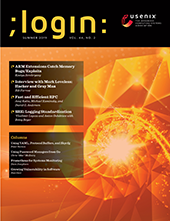
Structured Logging: Crafting Useful Message Content
;login: Enters a New Phase of Its Evolution
For over 20 years, ;login: has been a print magazine with a digital version; in the two decades previous, it was USENIX’s newsletter, UNIX News. Since its inception 45 years ago, it has served as a medium through which the USENIX community learns about useful tools, research, and events from one another. Beginning in 2021, ;login: will no longer be the formally published print magazine as we’ve known it most recently, but rather reimagined as a digital publication with increased opportunities for interactivity among authors and readers.
Since USENIX became an open access publisher of papers in 2008, ;login: has remained our only content behind a membership paywall. In keeping with our commitment to open access, all ;login: content will be open to everyone when we make this change. However, only USENIX members at the sustainer level or higher, as well as student members, will have exclusive access to the interactivity options. Rik Farrow, the current editor of the magazine, will continue to provide leadership for the overall content offered in ;login:, which will be released via our website on a regular basis throughout the year.
As we plan to launch this new format, we are forming an editorial committee of volunteers from throughout the USENIX community to curate content, meaning that this will be a formally peer-reviewed publication. This new model will increase opportunities for the community to contribute to ;login: and engage with its content. In addition to written articles, we are open to other ideas of what you might want to experience.

In the context of logging, the word "structured" typically refers to the way log records are represented in a machine-readable format, such as JSON or XML. In this article, we focus on another aspect of logging structure: the message content.
Computing today offers several automated ways of collecting, delivering, and processing log records from different types of systems. But modern technologies are not supportive if the information describing a specific event is insufficient or otherwise not helpful.
To approach this topic, it's useful to understand the most common logging issues, why they occur and possible solutions. By discussing some representative use cases, we aim to provide practical insights and approaches to improving the structure of your logs. As with most advice, our proposed solutions are just one way of approaching a problem space—feel free to either apply our suggestions wholesale or pick and choose the pieces that suit your needs.
